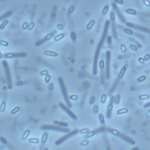Link to Pubmed [PMID] – 8757404
Mol. Gen. Genet. 1996 Jul;251(6):720-6
The intron-encoded endonuclease I-CeuI from Chlamydomonas eugametos was shown to cleave the circular chromosomes of all Clostridium perfringens strains examined at single sites in the rRNA operons, thereby generating ten fragments suitable for the rapid mapping of virulence genes by pulsed-field gel electrophoresis (PFGE). This method easily distinguishes between plasmid and chromosomal localisations, as I-CeuI only cuts chromosomal DNA. Using this approach, the genes for three of the four typing toxins, beta, epsilon, and tau, in addition to the enterotoxin and lambda-toxin genes, were shown to be plasmid-borne. In a minority of strains, associated with food poisoning, where the enterotoxin toxin gene was located on the chromosome, genes for two of the minor toxins, theta and mu, were missing.

